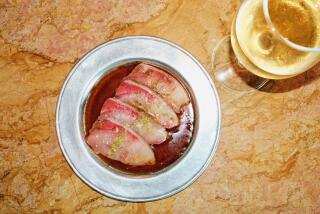What’s the State of the Art of Barbecuing? North Carolina, of Course : Barbecue: If you’re licking your chops for beef ribs, look elsewhere, pardner. This state uses only pigs.
I’ve had Dallas’ renowned Sonny Bryan’s barbecue--beef, of course, with a thick tomato-based chili-hot sauce--and revere it. I have toured the Kansas City barbecue spots immortalized by Calvin Trillin, which are closer to Texas than North Carolina, at least spiritually. I’ve had barbecue in Santa Fe and in Cleveland, which fancy themselves as new barbecue centers.
Admittedly, I have missed Tioga, Tex., and Little Rock, Ark., as well as hundreds of barbecue joints that millions of Americans pledge their loyalty to. Hunting for the definitive barbecue is the definition of infinity.
But when it comes to barbecue, if I can’t have infinity, give me North Carolina.
I arrived in Greensboro one Monday morning to meet a tasting team of good old boys gathered by a friend. They didn’t profess to be experts, just hungry guys who grew up on barbecue. Which means they know a lot about barbecue despite their modesty.
Don’t look for ribs in North Carolina--and certainly not beef. This barbecue-happy state uses only pigs, and indiscriminately reduces them to chopped barbecue. But proving that nothing is simple, North Carolina chopped barbecue can be subdivided into Eastern--Rocky Mount, Durham and thereabouts, with their spicier, vinegar-and-cayenne, basted whole-hog barbecue--and Western, of which Lexington is the spiritual center.
Western barbecue uses only the shoulder, and adds a little catsup to the thin, clear vinegar-pepper sauce (also called “dip”). Furthermore, the sauce is spooned on at serving time rather than basted onto the meat while it cooks.
Lexington, a town of 16,000 people and at least 18 barbecue joints, is widely believed to have the highest per-capita barbecue concentration in the country. And while every resident’s lineage may not be known, every barbecue joint has a visible place on the local family tree. They all descended from Sid Weaver and Jesse Swicegood, who in the early 1900s set up barbecue tents in the town square during court weeks, and stayed.
After trying a mere third of Lexington’s barbecues, I had absorbed the basic rules. First, drive around the place before going in. If there is no woodpile in the rear, drive on.
Second, forget the menu; it’s only diversion. What you want is a “tray” of “chopped outside” or “chopped brown,” preferably “coarse.” Once in a while you might order “sliced” for variety. Coarse means you want your meat hacked into big pieces rather than finely chopped; not only is the texture better, but it is more likely to be cut to order. And outside--or brown, as some refer to it--means that the dark, flavorful browned surface is included, not just the pale inside meat.
You could try a sandwich, but then you’d dilute the taste with bread. Or instead of a tray, you could order a plate, but then you’d be filling up with French fries rather than pork. A tray is a small cardboard bowl piled high with meat on one side and slaw on the other. Unless you’re addicted to Weight Watchers, you’ll make sure it comes not with a roll but with hush puppies. That’s the North Carolina barbecue trinity: pork, slaw and hush puppies. And in Lexington, it being a dry town, you wash the meal down with ice tea.
A North Carolinian is loyal to his barbecue. Buck, who works as a sales manager when he isn’t detailed to whisk me around Lexington, schedules his trips around the state with meals in mind.
Lexington’s No. 1’s meat is deeply crusty and elegantly pale, with smoky juices trapped in each absolutely lean hunk. The shoulders--salted but not basted--are cooked for eight to 10 hours over hickory and oak that have been reduced to coals. Once the meat has been smoked, trimmed and cut by hand, the 20-pound shoulders yield only 4 1/2 pounds of boneless meat. Its mellow vinegar and pepper sauce has a touch of sugar and a tinge of catsup. The slaw is sweet-sour, and the white-corn hush puppies are the lightest I have ever tasted. It is No. 1 in quality as well as longevity.
Next we cased Speedy’s, where there is a glaring absence of a woodpile but the pork skins, in huge gnarled slabs, are a heavenly way to thumb your nose at the medical establishment. Henry James, a barbecuer that is heretical enough to have opened branches in two other towns as well as to cook without a woodpile, compensates with an oniony, sweet-hot slaw. Whitley’s wins points for its slaw but loses them for the fatty, salty meat and greasy hush puppies. Smokey Joe’s has smoky-tasting meat, but it seems steam-softened and a tad stringy. But with five lunches under our belts, our pork-coated taste buds were getting lamer by the bite.
Jimmy’s fired up our spirit again. Only Jimmy’s competes with Lexington No. 1. Jimmy’s sauce is the hottest we found and simply great, tasting powerfully of vinegar and black pepper. His coarse chopped is really crunchy, his white-corn hush puppies are faintly sweet and very good. He sells out of pork-skin sandwiches, and Thursday through Sunday, when he makes his barbecued chicken and potato salad, crowded isn’t a sufficient word to describe the scene.
Lexington is tradition. Every detail of Lexington barbecue is so traditional that you could probably identify a place by the way it wraps its silverware. Lexington No. 1 rolls it in a paper napkin, as do Whitley’s and Smokey Joe’s. Speedy’s silverware comes in a wax-paper bag, Henry James’ in a standard plastic bag and Jimmy’s in a blown-film bag. As for the plates and trays, this is a cardboard town.
Memphis, on the other hand, serves its sauce-slathered ribs on anything from paper to china. We hit the town with vigor, enthusiastic for change, ready to tackle the thick red sauces and beef-pork-chicken-sausage variety of Memphis barbecue with unjaded taste buds. I even promised to try barbecued bologna. Barbecued spaghetti. Barbecued pizza. But only once.
Beer helped.
In Memphis, I learned, they do some things backward. They butter the rolls on the outside, and toast them after buttering. And oddly enough, the new places I tried tended to be better than the old. They even looked older than the old ones.
The most appropriate first stop had to be Elvis Presley Blvd. So Gridley’s, with its mustard-striped mansard roof, vinyl tablecloths and canned music, its four smokers’ tables ringed by non-smoking ones, was my introduction.
Gridley’s was middling. The ribs were chewy and insufficiently meaty, the chopped beef was indistinguishable from the chopped pork, but the thin, vinegary orange sauce was complex and stimulating. Next came Leonard’s, with food that tasted about what you’d expect from a chain barbecue. Its homemade icebox lemon pie was identified by Buck as “whipped cream they dragged a lemon through.” I was less sure it was whipped cream.
Jim Neely’s Interstate looks well-worn, and the bars on its windows and doors are uninviting. But inside there is a friendly flair. And despite the People magazine praise laminated on its menus, Interstate is down-home. Sliced meat comes in shreds, and the coleslaw has an aching sweetness, but Interstate serves a memorable, thick sweet-spicy sauce. It is particularly worthy of the crusty, smoky chopped beef. That beat out the ribs, for sure.
Corky’s is one of Memphis’s greatest crowd pleasers, and by 11:40 a.m. there is a 15-minute wait for lunch. The aroma of heavy smoke is right, and the sound is right--a light wafting of rock ‘n’ roll. But the look has yuppie-pub undertones, and the sauce is a timid mix whose main ingredients are, in descending order, catsup, water, molasses, brown sugar and corn syrup. Thus, it is the dry ribs--rubbed with spices rather than brushed with sauce--that show why Corky’s is so popular (and why it was hired to advise suburban Washington’s Red Hot & Blue).
With Willingham’s, our fourth Memphis barbecue, we were figuring the whole town was overrated. Willingham’s can provide one of the most entertaining afternoons of a lifetime if John Willingham is in talking form, for his life story is a yarn that keeps you on the edge of your seat, and his barbecuing machines--his own invention--are ingenious.
Willingham presses you to try every one of his WHAM (get it?) seasonings, and shouts orders to his wife--”Gimme a regular pig, walkin’.” His menu lists such concoctions as trash ribs and tenderwiches, and he is about to add spiced fried tenderloin strips--called fishing worms. But his marvelous revolving bicycle-wheel cooker, fired by sawdust and liquid smoke, leaves the ribs--which start out frozen--too greasy and crumbly, their sauce too caramelized.
More satisfying is the pulled pork, cleaned of all bits of fat and shredded by hand, with a grand meaty flavor. And the fried wings, rubbed with his dry spice mix, are sensational, at least without the sweet, smoky sauce. You get the sense of Willingham’s style from a brisket recipe hanging in his kitchen: “ 1/2 cup seasonings, 1/2 cup marinade, 3 tablespoons liquid smoke, 1/2-inch Pepsi per pan.”
It was a rainy Tuesday afternoon in Memphis, with three barbecues left to go. We sat in the Bar-B-Q Shop, listening to Rod Stewart and sipping beer, poring over the menu to figure out what we didn’t have to eat. I took over and ordered: a slab of wet, a slab of dry, two sandwiches and a cheese plate. Then the waitress turned to the others and asked what the rest of them wanted.
The Bar-B-Q Shop has got it right. The sauce is thick, red and snappy; the slaw is crunchy and tangy with pickle. The pork sandwich is thick, smoky and a lot of good meat for $2.65. But the ribs were a disappointment as the meat fell off the bone unbidden. Memphis pork is almost always overcooked, I began to conclude.
John Wills, even the older branch on Central Avenue, looks boringly pristine and impersonal. It is monumentally untempting, except for the two blackened chimneys that promise authentic smoked ribs.
But Memphis is a stereotype-bashing kind of town, and Wills served us the best barbecue in Memphis. The ribs are firm and chewy, neither tough nor steam-tenderized. The sauce has that magic balance of just enough vinegar, not too much tomato or sugar and plenty of spices roiling around. Mix it with the hot sauce on the table--which is an absolute humdinger on its own--and you have rib immortality. Blue-gray barn siding and green laminate aside, Wills’s barbecue tastes like an homage to tradition.
My group are Rendezvous fans. That may be because none of them actually lives in Memphis; Rendezvous is the tourist-laden kind of place that locals always scorn.
The portions are small by Memphis standards. And Rendezvous comes right out and boasts on its menu that the ribs are cooked over charcoal rather than hickory or oak logs. The food is served on foil-covered paper plates with plastic forks, which is tacky compared with the rest of Memphis’s barbecues. But scorned or not, Rendezvous is a hoot.
More to Read
Eat your way across L.A.
Get our weekly Tasting Notes newsletter for reviews, news and more.
You may occasionally receive promotional content from the Los Angeles Times.









